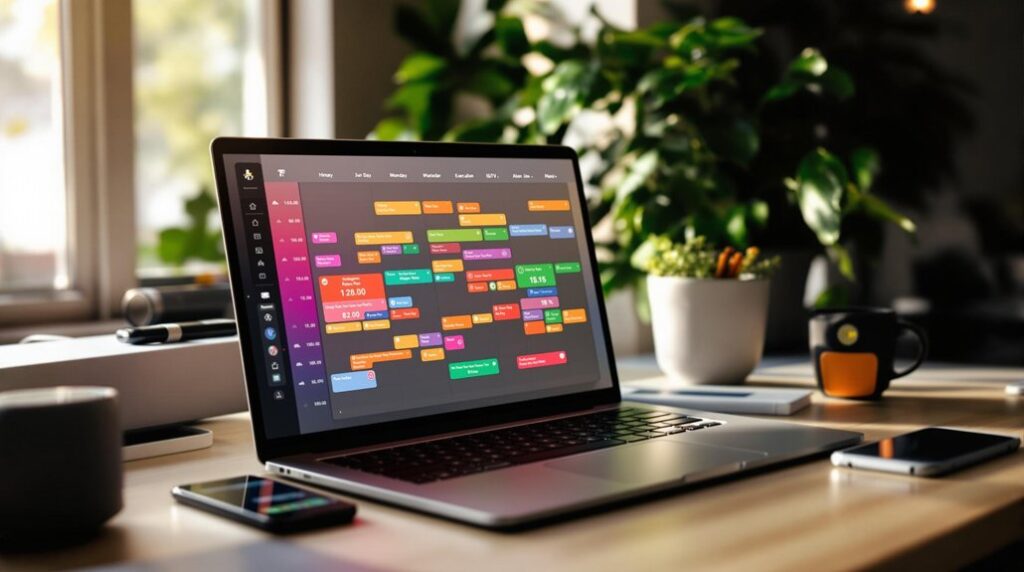Choosing between Later and Planoly depends largely on your brand's specific needs. Later supports a wider range of platforms, offers advanced analytics, and features like Linkin.bio for e-commerce integration, although at a higher starting cost of $18/month. Planoly, at $13/month, is more cost-effective for brands focused solely on Instagram and TikTok, providing niche planning tools and visually appealing scheduling. Both offer user-friendly interfaces but Later scores higher in user satisfaction. Free trials provide an opportunity to evaluate their usability and features. Each platform's unique strengths can be leveraged to enhance your social media strategy further.
Key Takeaways
- Later supports more platforms than Planoly, making it ideal for businesses with diverse social media needs.
- Planoly is more affordable, starting at $13/month, compared to Later's $18/month, benefiting smaller budgets.
- Later offers robust analytics and reporting features for in-depth audience insights across multiple accounts.
- Planoly's unique TikTok planner and trending audio tools cater to influencers and content creators on specific platforms.
- Later's Linkin.bio feature enhances e-commerce engagement, benefiting brands looking to drive sales through social media.
Platform Overview
How do Planoly and Later differentiate themselves in the competitive landscape of social media scheduling tools? Both platforms excel in Instagram scheduling but cater to different user needs and strategic objectives.
Planoly, founded in 2016, targets individual influencers and small businesses with a focus on Instagram, TikTok, and Pinterest. It offers content planning and analytics tailored for these platforms, making it an ideal choice for users prioritizing Instagram-centered strategies. Planoly's pricing starts at $13/month, with a 7-day free trial to explore its features, including a grid format for post arrangement. Analyzing engagement rates helps users identify resonant content with their followers, enabling better-targeted strategies.
Conversely, Later, established in 2014, supports a broader array of social media platforms, including Instagram, Facebook, Twitter, Pinterest, TikTok, and LinkedIn. This makes it a versatile social media management tool for marketers and agencies managing diverse accounts. Its offerings include a visual content calendar and a clean, organized user interface, appealing to those who value extensive content planning across multiple channels.
Later's pricing begins at $18/month, with a more extended 14-day free trial, and tiered pricing that reflects the depth of its features and analytics capabilities. Both platforms provide distinct advantages through their pricing tiers and feature sets, catering to varied user requirements.
User Interface Comparison
In the domain of user interface design, Later and Planoly offer distinct approaches that cater to their specific user bases. Later's interface stands out for its clean, organized presentation, integrating a visual content calendar and drag-and-drop scheduling to enhance user-friendliness across multiple social media platforms. This streamlined approach facilitates ease of use, allowing users to manage their posts efficiently. Later's inclusion of a media library and file upload tab further improves navigation efficiency by enabling seamless media import, thereby enhancing overall user experience. Conversely, Planoly provides a visually appealing user interface, primarily targeted towards Instagram, TikTok, and Pinterest. Although it incorporates drag-and-drop scheduling similar to Later, Planoly's lack of a dedicated media library can complicate navigation, potentially affecting its interface complexity negatively. However, Planoly's focus on specific platforms may still satisfy users seeking specialized features for these networks. Furthermore, anonymity during engagement reduces pressure and enhances exploration of trends for users of both platforms. In terms of satisfaction score, users rate Later slightly higher, scoring 9.2/10 compared to Planoly's 9.0/10 for ease of use. This indicates a marginal preference towards Later's user interface, attributed to its thorough media management capabilities and streamlined user experience, which may align better with broader social media management needs.
Scheduling Features
Building on the evaluation of user interfaces, the scheduling features of Later and Planoly reveal additional differentiation in their offerings.
Later stands out with its robust visual content calendar, boasting drag-and-drop functionality that enables seamless content scheduling across multiple platforms, including Instagram, Facebook, Twitter, Pinterest, and LinkedIn. This feature is particularly beneficial for brands looking to manage multiple accounts effortlessly.
Moreover, Later's auto-publishing capability guarantees that once content is scheduled, it posts automatically, requiring no extra user intervention—streamlining the entire process.
Conversely, Planoly focuses its scheduling features on Instagram, TikTok, and Pinterest. Its visual planner utilizes a grid format, allowing users to strategically organize their feeds in a manner that aligns with their brand aesthetic.
Planoly also includes a dedicated TikTok planner, which is a distinctive feature, especially for brands targeting audiences on video-centric platforms. Additionally, the ability to save audio from trending content is a unique offering that caters to Instagram and TikTok users specifically.
Both Later and Planoly facilitate Instagram Stories scheduling, but Later provides enhanced support for managing multiple account feeds, making it a versatile choice for users handling diverse social media portfolios.
Additionally, platforms like TailwindApp incorporate real-time analytics to help refine and enhance publishing strategies, leading to continuous improvement and better performance outcomes.
Analytics Capabilities
Understanding the analytics capabilities of Instagram schedulers like Later and Planoly is essential for businesses aiming to refine their social media strategies.
Later analytics offers a thorough suite of tools that provide key performance indicators (KPIs) such as engagement rates, post impressions, and ideal posting times. This makes Later a strategic asset for businesses looking to enhance content performance across multiple social media platforms. Its detailed reporting capabilities enable informed marketing strategies, offering extensive audience insights that go beyond Instagram metrics alone.
In contrast, Planoly analytics focuses primarily on Instagram and TikTok, providing basic insights such as the best time to post and a general overview of engagement. While this may suffice for individual content creators, businesses managing diverse accounts might find it limiting.
The analytics capabilities of Planoly are more confined compared to Later, particularly in lower-tier plans which lack robust features.
For brands seeking thorough Instagram metrics across various social media platforms, Later's advanced analytics and detailed reporting provide a competitive edge. Its ability to cater to higher-tier users with custom reporting and extensive audience insights makes it a versatile choice for businesses aiming to enhance their marketing strategies effectively.
Understanding your Instagram audience demographics is crucial for refining content strategies, and insights from these analytics tools can help businesses tailor their engagement methods.
Additional Tools
How do Instagram schedulers like Later and Planoly differentiate themselves through additional tools?
Later distinguishes itself with its Linkin.bio feature, which transforms Instagram and TikTok profiles into dynamic, shoppable web pages, enhancing engagement tracking through detailed analytics. This tool is invaluable for brands seeking to optimize their social media management strategies by offering interactive and monetizable content experiences.
Planoly, however, does not offer an equivalent feature, which might limit its appeal for businesses focusing on e-commerce integration.
In terms of media management, Later again takes the lead with a dedicated media library, streamlining the content planning process by providing easy access to uploaded assets.
Planoly lacks this feature, potentially complicating the organization of visual content strategies for users with extensive media needs.
Both Instagram schedulers have strong educational resources, but Later's emphasis on webinars and blogs focuses more strategically on visual content strategies, while Planoly provides in-depth articles on brand building and content strategies.
When considering free trials, Later offers a 14-day trial compared to Planoly's 7-day option, allowing users more time to explore their extensive scheduling tools and analytics capabilities before committing, thereby supporting informed decision-making.
In addition to these features, profile optimization is crucial for success on Instagram, and tools like Later and Planoly play a significant role in ensuring consistent posting frequency and content quality.
Pricing Options
Steering through the pricing options for Instagram schedulers like Later and Planoly is essential for choosing a tool that aligns with your strategic objectives and budget constraints.
Both platforms offer tiered subscription costs, catering to different social media management needs. Planoly's pricing begins at $13/month for the Starter plan, escalating to $43/month for the Professional plan. In contrast, Later's monthly plans start at $18, reaching up to $80 for the Advanced plan.
Both offer annual subscriptions, providing significant savings: Planoly offers up to 15% off, while Later provides two months free.
For users seeking a no-cost introduction, both Later and Planoly offer free plans. Planoly allows up to 30 uploads per month, while Later offers 30 posts per profile with 1 social set. These options allow users to explore basic features without financial commitment.
Importantly, Later's higher subscription costs are justified by its extensive features and multi-platform support, making it ideal for businesses with thorough social media management needs.
Conversely, Planoly's pricing structure is more suited for individual influencers and small businesses looking for a cost-effective yet efficient scheduling tool.
Both platforms can benefit from engaging subscribers with interactive content, which boosts engagement and retention. Each platform presents distinct features and pricing options, demanding a strategic assessment of brand needs.
Choosing the Right Fit
Maneuvering the landscape of Instagram schedulers requires not only evaluating pricing but also understanding which tool aligns best with your brand's unique needs.
For social media managers handling multiple social media accounts, Later's ability to support six platforms is invaluable. This feature is essential for brands that require efficient scheduling across a wide digital presence.
Conversely, Planoly's focus on Instagram, TikTok, and Pinterest makes it a strategic choice for those prioritizing niche platforms with visually-driven content.
When considering a budget-friendly option, Planoly's starting price of $13/month makes it accessible for solo entrepreneurs or small businesses. In comparison, Later's $18/month Starter plan may better suit larger teams needing robust cross-platform capabilities.
Both offer free trials, with Later providing a 14-day period, double that of Planoly, allowing for a more detailed evaluation of features.
Analytics is another critical factor. Later offers advanced analytics for multiple channels, ideal for brands needing extensive performance insights.
Planoly, with its Instagram-focused analytics, caters to those who prioritize visual aesthetics and Instagram content.
Ultimately, the choice between Planoly vs. Later depends on your specific content creation needs and desired user-friendly interface.
Incorporating key metrics and performance evaluation into your strategy can further enhance your understanding of how each scheduler can be utilized to optimize content performance and audience engagement.
Frequently Asked Questions
Which Is Better, Planoly or Later?
Determining the superior platform depends on priorities. Planoly features focus on Instagram, offering basic analytics and cluttered visuals. Later offers broader integration options, superior analytics tools, and flexible scheduling. Later's pricing reflects enhanced user experience and customer support.
What Is the Best Scheduler for Instagram?
Determining the best Instagram scheduling tool involves analyzing user interface, pricing comparison, analytics features, visual planning, content management, and integration capabilities. Consider brand alignment, customer support, and mobile accessibility to select a scheduler that meets strategic objectives.
What Is Better Than Planoly?
An ideal alternative to Planoly should excel in Instagram growth strategies, offer advanced social media analytics, and provide robust scheduling automation benefits. It should enhance visual content planning, audience targeting, brand aesthetic alignment, and competitive analysis tools.
Is Later a Good Scheduling Tool?
Later is an excellent scheduling tool, offering features like visual planning, scheduling efficiency, and robust analytics insights. Its user-friendly interface, mobile accessibility, and content organization facilitate team collaboration, optimize post timing, and provide reliable customer support.
Conclusion
In evaluating Later and Planoly as Instagram scheduling tools, each platform offers distinct advantages tailored to specific needs. Later excels with its intuitive user interface and robust analytics, appealing to brands prioritizing data-driven strategies. Conversely, Planoly's thorough scheduling features and additional tools cater to users seeking enhanced content management capabilities. Pricing structures also vary, influencing the decision-making process. Ultimately, selecting the appropriate platform depends on aligning brand objectives with the unique features and pricing that each tool provides.




